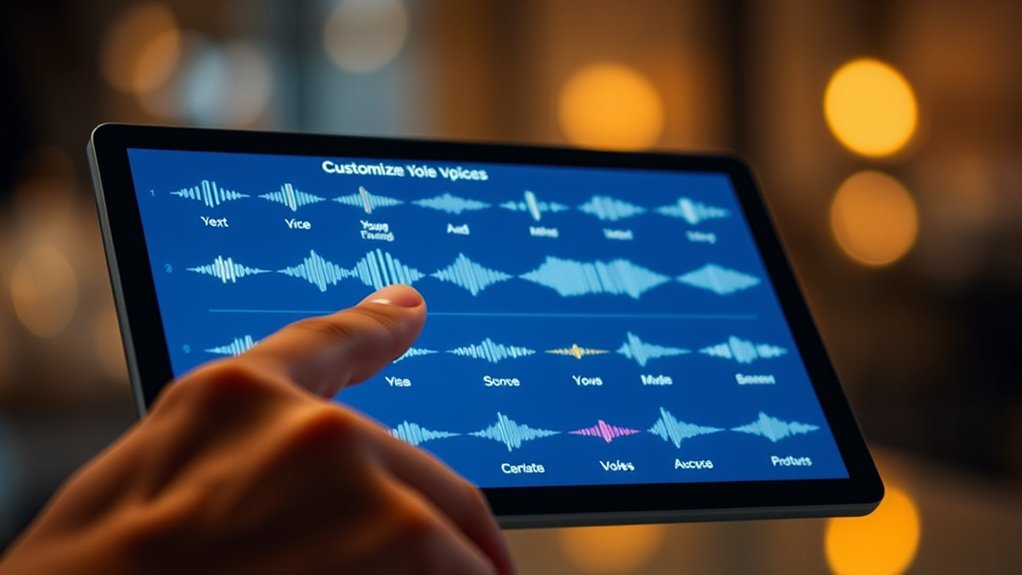When considering what makes OpenAI’s Text to Speech voice stand out, you’ll notice its remarkable versatility across various applications. It’s not just about sounding human; it’s about capturing emotions and nuances that resonate with listeners. This technology employs advanced machine learning algorithms to achieve a natural flow. But there’s more to it—customization options allow users to tailor their experience. What other features contribute to its uniqueness?
Key Takeaways
- OpenAI’s Text to Speech voice supports over 130 languages and voices, catering to a diverse global audience.
- It utilizes advanced machine learning algorithms to create speech that closely mimics natural human characteristics.
- The voice exhibits a wide emotional range, enhancing listener engagement and connection through nuanced delivery.
- Customization options allow users to adjust pitch, speed, and voice type for a personalized experience.
- Its natural intonation and rhythm provide realistic delivery, avoiding monotony and effectively conveying emotions and intent.
Versatility Across Applications

OpenAI’s text-to-speech voice stands out not just for its quality, but also for its versatility across a wide range of applications. Whether you’re creating engaging audiobooks, enhancing accessibility for the visually impaired, or adding voiceovers to videos, this technology adapts effortlessly to your needs. You can use it for educational purposes, turning written content into spoken words, or for customer service chats, providing a human-like interaction. It’s also great for gaming, where immersive storytelling benefits from realistic voice delivery. This flexibility allows you to explore innovative ways to connect with your audience, making your content more engaging and relatable. You’ll appreciate how easily it integrates into various platforms, enhancing user experience without compromising quality. Additionally, it supports over 130 languages and voices, ensuring a broad reach for diverse audiences.
Emotional Range and Expressiveness
While many text-to-speech systems focus solely on clarity, the emotional range and expressiveness of OpenAI’s voice truly set it apart. You’ll notice how it can convey different feelings, from excitement to sadness, making interactions feel more genuine. This ability to capture emotion lets you connect with the content on a deeper level, enhancing your overall experience. Whether you’re listening to a story, a presentation, or an educational module, the nuanced delivery can evoke a range of reactions, keeping you engaged. You’ll appreciate how it adapts its tone and cadence to match the context, transforming mundane information into something lively and relatable. In short, it creates a more immersive auditory experience, making communication feel more human.
Advanced Machine Learning Algorithms

As you explore the capabilities of OpenAI’s text-to-speech technology, you’ll find that advanced machine learning algorithms play a crucial role in its performance. These algorithms enable the system to analyze vast amounts of data, learning patterns and nuances in human speech. By applying techniques like deep learning, the technology can synthesize speech that closely mimics natural human voice characteristics. This means that not only is the output more accurate, but it also adapts to different contexts and user needs. The algorithms continuously improve over time, learning from user interactions and feedback. This adaptability guarantees that the text-to-speech experience remains relevant and effective, making it a powerful tool for various applications, from virtual assistants to accessibility solutions.
Natural Intonation and Rhythm
The advanced machine learning algorithms that power OpenAI’s text-to-speech technology not only analyze data but also capture the subtleties of human communication, including natural intonation and rhythm. This means when you listen to the generated voice, you’ll notice it sounds more like a real conversation than a robotic voice. The technology mimics the natural rise and fall of speech patterns, making it easier for you to engage with the content. You won’t hear a monotonous tone; instead, the voice varies its pitch and pace just like humans do in everyday dialogue. This realistic delivery helps convey emotions and intent, ensuring that what you hear resonates with you on a deeper level, enhancing your overall experience.
User-Centric Customization Options

When you engage with OpenAI’s text-to-speech technology, you’ll find a range of user-centric customization options designed to tailor the experience to your preferences. You can adjust voice characteristics like pitch and speed, ensuring the output sounds just right for your needs. Additionally, you can choose from various voice types, allowing for a more personalized interaction.
Here’s a quick overview of some customization features:
| Feature | Description | Example Setting |
|---|---|---|
| Pitch | Adjusts the voice frequency | Higher or lower tones |
| Speed | Changes the speaking tempo | Fast, normal, slow |
| Voice Type | Select different voice personas | Male, female, robotic |
These options enhance your experience, making it more engaging and suited to your requirements.
